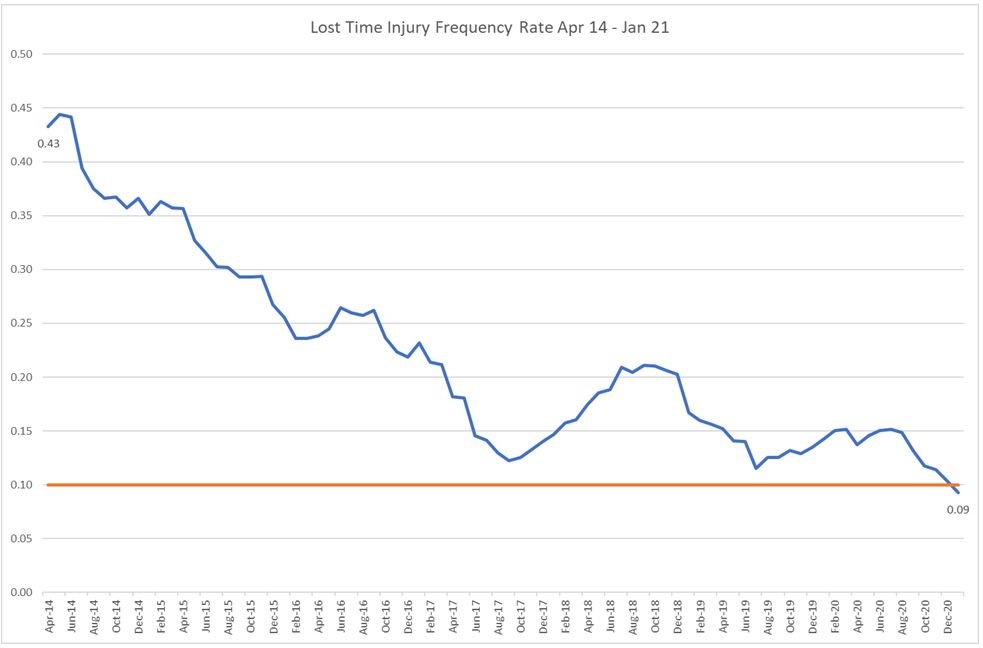lost time injury frequency rate
Breaking the 0.1 lost time injury frequency rate plateau
Karl Simons, Chief Health, Safety & Wellbeing Officer at Thames Water, talks to SHP about the work that has gone in to achieving a LTIFR of 0.09 for the first month of 2021.
What is the lost time injury frequency rate plateau?
 As any health and safety professional or leader should know the daily prevention of harm is the ultimate goal. This is never more true than in organisations working in safety critical industries. By this I mean sectors such as rail, construction, oil, gas, minerals, utilities, etc…most of which I have spent time in. By far the greatest challenge in these sectors, in a mature reporting culture such as the UK, is breaking the 0.1 LTIFR plateau when measuring time off for all those working for and on their behalf, that’s both employees and contractors, unable to return to work after a workplace injury. For those not familiar this is the annual total volume of Lost Time Injuries (LTIs) multiplied by 100,000 divided by the total hours worked. Then you will need to turn this into a rolling frequency rate so will need 24 months of data.
As any health and safety professional or leader should know the daily prevention of harm is the ultimate goal. This is never more true than in organisations working in safety critical industries. By this I mean sectors such as rail, construction, oil, gas, minerals, utilities, etc…most of which I have spent time in. By far the greatest challenge in these sectors, in a mature reporting culture such as the UK, is breaking the 0.1 LTIFR plateau when measuring time off for all those working for and on their behalf, that’s both employees and contractors, unable to return to work after a workplace injury. For those not familiar this is the annual total volume of Lost Time Injuries (LTIs) multiplied by 100,000 divided by the total hours worked. Then you will need to turn this into a rolling frequency rate so will need 24 months of data.
Is it a target?
This is something I and those working closely alongside me over so many years have had our sites firmly set on and is more of a milestone as opposed to target, but an incredibly challenging milestone for a company to achieve. As an organisation with over 7,000 sites and turnover of £2bn per annum, our daily challenges at Thames Water are extraordinary and relentless, so I am delighted that last month we have collectively achieved this incredible milestone with a LTIFR of 0.09.

How has it been achieved?
Having been at Thames for eight years, I have watched my dedicated and amazing safety and health team have work tirelessly to develop, introduce and embed waves of initiatives that have supported our workforce in the creation of our culture of care. It’s been an incredible journey thus far for us steering leadership, supporting competency up-skilling, creating opportunities for engagement and relentlessly communicating in both safety and health standards and expectations to create a safer and healthier workplace for all.
How have contractors been affected?
At Thames Water two thirds of our work is undertaken by our supply chain partners, so working closely with them is crucial to attaining successes in safety and health management. We have developed a framework which provides clear lines of direct engagement with 112 organisational leaders involved affecting our total 4,500 supply chain companies on our books. At the helm of this engagement framework is our Health & Safety Leadership Team which consists of 15 Operational Directors from our major Tier 1 contracting partners who give their time every month to meet with me and have played an instrumental part in our success. Together this group have have worked to create an environment of openness, collaboration and trust which enables sharing to be on a level without fear of reprisal. This transparency has promoted mature learning, focussed engagement and enabled the development of our suite of Essential Standards which are contractual obligations across all our supply chain and steer expectations, which go well beyond the statutory requirements.
Is this a Key Performance Indicator?
It’s been a topical discussion in the health and safety profession over the years about what should be measured in regards to both leading and lagging indicators. Although never an exact science my personal view is to always concentrate almost all your effort on the leading indicators and generate initiatives that affect these. The lagging then simply become a byproduct that can be learned from. When it comes to the lagging side most organisations in these sectors measure a series of injury rates including the RIDDOR Frequency rate (AFR) or total injury rate. My personal view is many of these can be misleading and easily manipulated, for example often people feel a sense of duty to push themselves back to work early to avoid something becoming notifiable to the Regulator or on the other end of the scale minor injuries such as cuts and scrapes may be considered just scratch’s and not be reported in some of our harder engineering sectors such as construction. So concentrating on the LTIs will give you the best chance of getting an accurate picture as if someone is unable to come into work following a workplace injury you’ll likely know about it straight away.
What’s next?
Over the years I and my team have constantly strived to share the steps we have taken so others can benefit and this is something we are extremely proud of. As a pure optimist I continually look to the future with excitement as the Health & Safety profession continues to increase in profile and visibility within organisations as a result of its effort in protecting all those in work
Breaking the 0.1 lost time injury frequency rate plateau
Karl Simons, Chief Health, Safety & Wellbeing Officer at Thames Water, talks to SHP about the work that has gone in to achieving a LTIFR of 0.09 for the first month of 2021.
Karl Simons OBE
SHP - Health and Safety News, Legislation, PPE, CPD and Resources Related Topics
Safety Leadership: From virtual safety to real safety
Lives depend on asbestos action, says IOSH
HSE acknowledge issue of ill-fitting PPE as regulator engage with SHP

 As any health and safety professional or leader should know the daily prevention of harm is the ultimate goal. This is never more true than in organisations working in safety critical industries. By this I mean sectors such as rail, construction, oil, gas, minerals, utilities, etc…most of which I have spent time in. By far the greatest challenge in these sectors, in a mature reporting culture such as the UK, is breaking the 0.1 LTIFR plateau when measuring time off for all those working for and on their behalf, that’s both employees and contractors, unable to return to work after a workplace injury. For those not familiar this is the annual total volume of Lost Time Injuries (LTIs) multiplied by 100,000 divided by the total hours worked. Then you will need to turn this into a rolling frequency rate so will need 24 months of data.
As any health and safety professional or leader should know the daily prevention of harm is the ultimate goal. This is never more true than in organisations working in safety critical industries. By this I mean sectors such as rail, construction, oil, gas, minerals, utilities, etc…most of which I have spent time in. By far the greatest challenge in these sectors, in a mature reporting culture such as the UK, is breaking the 0.1 LTIFR plateau when measuring time off for all those working for and on their behalf, that’s both employees and contractors, unable to return to work after a workplace injury. For those not familiar this is the annual total volume of Lost Time Injuries (LTIs) multiplied by 100,000 divided by the total hours worked. Then you will need to turn this into a rolling frequency rate so will need 24 months of data.
Can we have the number of hours worked each month up until this point? And does this include supply chain working hours, ad-hoc projects – or just TW only colleague hours?
Great achievement Karl, now the hard work really begins keeping it under .well done to your team and the general work force at Thames water.
Thats a great article Karl. Whilst I work to similar metrics, we dont actaully target an AFR or TRIR rate to get below, rather, we just use it as a tracking system to discuss monthly rates and the reason for why it may have risen or fallen etc (I’m not trying to advocate one way or the other is more orr less beneficial). I particularly like your approach to working together with your team and external contractors to create an environment of openness, collaboration and trust, and I can only imagine that this must have taken a huge amount of… Read more »
While this achievement is extremely laudable, it does concern me when so much emphasis is placed on LTIs in a process environment. You only have to look at the consequences of Piper Alpha, Texas City and Macondo to see examples of where LTI was their focus but their respective eyes missed the process safety issues and the consequences horrendous. The article doesn’t make clear whether process safety has been adequately addressed but it would help clarify to what extent it has.
Hi Carl – a good article, and for bigger employers this measurement approach is understandable, and in many ways correct. I particularly like your use of “signpost” as opposed to “Target, which can suggest we may not have had enough accidents yet !. For the smaller business, say less than 20 employees, a single event will skew the figures. In my opinion the All Injury Frequency Rate (AIFR) can be just as interesting as the RIDDOR rate. Near Miss / Near Hit (or whatever you chose to call them) rates and trending also have a clear message to tell –… Read more »
With 58% of DSE operators still suffering debilitating levels of presenteeism, at high risk of visual repetitive stress injuries / visual suppression and monocular adaptations, myopic and/or asthenopic disease due to over-exposure to standard unmitigated or “reasonably adjusted” display screen interface for accessibility exhibiting 20% lost productivity, or one day in five, you would think all employers would want to comply with ISO 30071.1 as well as WCAG 2.1 Colour Contrast Validation to optimise Accessibility, wouldn’t you?
Well done, a survey would be a great way for senior management to confirm the safety data is a milestone and not a target, having been on large projects and witnessed behaviour at all levels.